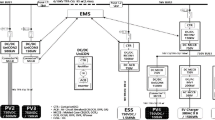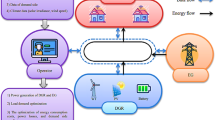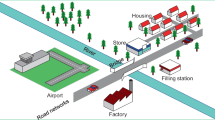Abstract
A potential energy framework for assessment of grid vulnerability was presented. In the framework, the branch potential energy function model was constructed. Two indexes, current vulnerability and forecasting vulnerability, were calculated. The current vulnerability was used to identify the current vulnerable area through calculating the distance between the current transmitted power and initial transmitted power; and the forecast vulnerability under variation of power injection was used to predict the vulnerable area of next step and verify the current vulnerable area. Numerical simulation was performed under variant operating conditions with IEEE-30 bus system, which shows that almost area of 90% overlaps between current vulnerable area and forecasting vulnerable area, the overlapped area is termed as inherent vulnerable area of grid. When considering N-1 contingency, the assessment results of this method proposed agree with those of optimal power flow. When considering N-2 contingency, optimal power flow fails to obtain correct results, while the method based on energy framework gives reliable results.
Similar content being viewed by others
References
FOUAD A A, QIN Z, VITTAL V. System vulnerability as a concept to assess power system dynamic security [J]. IEEE Transactions on Power Systems, 1994, 9(2): 1009–1015.
LIU Qun-ying, LIU Jun-yong, LIU Qi-fang. Power grid vulnerability assessment based on branch potential energy information [J]. Automation of Electric Power Systems, 2008, 32(10): 6–11. (in Chinese)
YU X B, SINGH C. A practical approach for integrated power system vulnerability analysis with protection failures [J]. IEEE Transactions on Power Systems, 2004, 19(4): 1811–1820.
CHEN Wei-hua, JIANG Quan-yuan, CAO Yi-jia. HVDC system vulnerability assessment based on models combination and risk theory [J]. Automation of Electric Power System, 2005, 29(21): 19–24. (in Chinese)
CHEN Xiao-gang, SUN Ke, CAO Yi-jia. Structural vulnerability analysis of large power grid based on complex network theory [J]. Transactions of China Eelectrotechnical Society, 2007, 22(10): 138–144. (in Chinese)
CAO Yi-jia, CHEN Xiao-ming, SUN Ke. Identification of vulnerable lines in power grid based on complex network theory [J]. Electric Power Automation Equipment, 2006, 26(12): 1–5. (in Chinese)
DING Ming, HAN Ping-ping. Vulnerability assessment to small-world power grid based on weighted topological model [J]. Automation of Electric Power System, 2008, 28(10): 20–25. (in Chinese)
ZHANG Guo-hua, WANG Ce, ZHANG Jian-hua, YANG Jing-yan. Vulnerability assessment of bulk power grid based on complex network theory [C]// Proceedings of the Third International Conference on Electric Utility Deregulation and Restructuring and Power Technologies. Nanjing: IEEE Computer Society, 2008: 1554–1558.
DING Jian, BAI Xiao-min, ZHAO Wei, LI Zai-hua. Grid vulnerability analysis based on two-dimensional accumulation means [J]. Automation of Electric Power Systems, 2008, 32(8): 1–4. (in Chinese)
BALDICK R, CHOWDHURY B, DOBSON I. Vulnerability assessment for cascading failures in electric power systems [C]// Proceedings of Power Systems Conference and Exposition. Seattle: IEEE Computer Society, 2009: 1–9.
HAIDAR A M A, MOHAMED A, HUSSAIN A. Vulnerability assessment of a large sized power system using radial basis function neural network [C]// Proceedings of the 5th Student Conference on Research and Development. Selangor: IEEE, 2007: 1–6.
MINGOO K, ELSHARKAWI M A, MARKSR J. Vulnerability indices for power systems [C]// Proceedings of the 13th International Conference on Intelligent Systems Application to Power Systems. Arlington: IEEE, 2005: 7.
INNOCENT K, ASHOK K P, GEZA J. Automatic segmentation of large power systems into fuzzy coherent areas for dynamic vulnerability assessment [J]. IEEE Transactions on Power Systems, 2007, 22(4): 1974–1985.
DOORMAN G L, UHLEN K, KJOLLE G H, HUSE E S. Vulnerability analysis of the Nordic power system [J]. IEEE Transactions on Power Systems, 2006, 21(1): 402–410.
LIU Ji-cheng, NIU Dong-xiao. A novel recurrent neural network forecasting model for power intelligence center [J]. Journal of Central South University of Technology, 2008, 15(5): 726–732.
KAMWA I, PRADHAN A K, JOOS G, SAMANTARAY S R. Fuzzy partitioning of a real power system for dynamic vulnerability assessment [J]. IEEE Transactions on Power Systems 2009, 24(3): 1356–1365.
DONALD M, KHALIL E A, REGINALD B, GEZA J. Areas of vulnerability in an environment of uncertainty [C]// Proceedings of Canadian Conference on Electrical and Computer Engineering. Vancourer: Institute of Electrical and Electronics Engineers Inc., 2007: 268–271.
Author information
Authors and Affiliations
Additional information
Foundation item: Project(51007006) supported by the National Natural Science Foundation of China; Project(20090185120023) supported by the Ph.D Programs Foundation for New Teacher of Ministry of Education of China
Rights and permissions
About this article
Cite this article
Liu, Qy., Liu, Qf., Huang, Q. et al. Assessment of grid inherent vulnerability considering open circuit fault under potential energy framework. J. Cent. South Univ. Technol. 17, 1300–1309 (2010). https://doi.org/10.1007/s11771-010-0635-9
Received:
Accepted:
Published:
Issue Date:
DOI: https://doi.org/10.1007/s11771-010-0635-9




